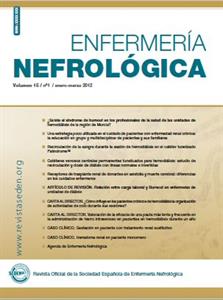Contenido del artículo principal
Resumen
Se trata de un estudio transversal con 73 pacientes que recibieron un trasplante renal durante el año 2010, 18 procedentes de donante en muerte cerebral y 55 en asistolia. Los trasplante renales de donante en asistolia presentaron mayor incidencia de fallo primario del injerto (15% vs 1,4%) así como mayor retraso de la función renal (18 días vs 0 días). Debido a esto, nuestra labor asistencial se vio incrementada en este tipo de trasplante por precisar un mayor número de biopsias renales que implican unos cuidados de preparación y de vigilancia de sus complicaciones, la necesidad de más sesiones de hemodiálisis y la administración de un mayor número de dosis de timoglobulina. No se objetivaron diferencias significativas en la incidencia de infecciones entre ambos tipo de trasplante, así como en la estancia media hospitalaria, aunque esto último podría estar influido por el tamaño de la muestra.
A pesar de las complicaciones mencionadas, la función renal a medio plazo de ambos tipos de trasplante fue similar, lo que alienta la utilización de los donantes en asistolia.
Palabras clave
Detalles del artículo
Derechos de autor 2012 Mª Concepción García Viana, Silvia Moral Sánchez, Raquel Rodríguez Marcos, Teresa Lope Andrea, Natalia Ridao Cano

Esta obra está bajo una licencia internacional Creative Commons Atribución-NoComercial 4.0.
Aviso de derechos de autor/a
© Los autores ceden de forma no exclusiva los derechos de explotación de los trabajos publicados y consiente en que su uso y distribución se realice con la Licencia Creative Commons Atribución - No comercial 4.0 Internacional (CC BY-NC 4.0). Puede consultar desde aquí la versión informativa y el texto legal de la licencia. Esta circunstancia ha de hacerse constar expresamente de esta forma cuando sea necesario.
Referencias
- Morales Ruiz E. Trasplante renal anticipado. Guias SEN.Volumen 28. 2008; 3: 123-128.
- Lopez-Navidad A., Kulisevsky J., Caballero F. El donante de órganos y tejidos. Springer-Verñag Ibérica, Barcelona 1997; 3: 27.
- Ortega F., Arias M., Campistol J.M., Matesanz R., Morales J.M. Trasplante Renal. Médica Panamericana, 2007; 3: 39.
- Rampino T, Abelli M, Ticozzelli E, Gregorini M. Nonheart-beating-donor transplant: the first experience in Italy. PMID: 20191461 [PubMed- indexed for Medline] 2010 Jan- Feb; 27(1):56-68 [consultado el 6 de abril de 2011]. Disponible en http://www.ncbi.nlm.nih.gov/pubmed/20191461.
- Kosieradzki M, Rowinski W. Ischemia/reperfusion injury in kidney transplantation: mechanisms and prevention. PMID: 19100373 [PubMed- indexed for Medline] 2008 Dec; 40(10):32-79-88 [consultado el 6 de abril de 2011]. Disponible en http://www.ncbi.nlm.nih.gov/pubmed/19100373.
- Sánchez-Fructuoso AI, Prats D, Torrente J, PérezContin MJ, Fernandez C, Álvarez J, Barrientos A. Renal transplantation from non-heart beating donors: a promising alternative to enlarge the donor pool. J Am Soc Nephrol 2000; 11: 350-358.
- Kimber RM, Metcalfe MS, White SA, Nicholson ML. Use of nos-heart-beating donors in renal transplantation. Postgrad Med J 2001;77:681–685.
- Gutiérrez-Solís E, Fernández Juárez G. NefroPlus. Junio 2010. 3(1):16-27 [consultado 1 abril de2011]. Disponible en http://www.revistanefrologia.
- com/modules.php?name=articulos&idarticulo=10471&idlangart=ES.
- Palencia Herrejón E. Trasplante renal de donantes en asistolia. Revista
- electrónica de medicina intensiva. Julio 2002. Art 418. Vol 2 nº 7[consultado 2 abril de 2011]. Disponible en http://remi.uninet.edu/2002/07/REMI0418.htm.
- Andreu Periz L, Force Sanmartin E. La enfermería y el trasplante de órganos. Médica Panamericana, 2004; 2: 22.
Referencias
Morales Ruiz E. Trasplante renal anticipado. Guias SEN.Volumen 28. 2008; 3: 123-128.
Lopez-Navidad A., Kulisevsky J., Caballero F. El donante de órganos y tejidos. Springer-Verñag Ibérica, Barcelona 1997; 3: 27.
Ortega F., Arias M., Campistol J.M., Matesanz R., Morales J.M. Trasplante Renal. Médica Panamericana, 2007; 3: 39.
Rampino T, Abelli M, Ticozzelli E, Gregorini M. Nonheart-beating-donor transplant: the first experience in Italy. PMID: 20191461 [PubMed- indexed for Medline] 2010 Jan- Feb; 27(1):56-68 [consultado el 6 de abril de 2011]. Disponible en http://www.ncbi.nlm.nih.gov/pubmed/20191461.
Kosieradzki M, Rowinski W. Ischemia/reperfusion injury in kidney transplantation: mechanisms and prevention. PMID: 19100373 [PubMed- indexed for Medline] 2008 Dec; 40(10):32-79-88 [consultado el 6 de abril de 2011]. Disponible en http://www.ncbi.nlm.nih.gov/pubmed/19100373.
Sánchez-Fructuoso AI, Prats D, Torrente J, PérezContin MJ, Fernandez C, Álvarez J, Barrientos A. Renal transplantation from non-heart beating donors: a promising alternative to enlarge the donor pool. J Am Soc Nephrol 2000; 11: 350-358.
Kimber RM, Metcalfe MS, White SA, Nicholson ML. Use of nos-heart-beating donors in renal transplantation. Postgrad Med J 2001;77:681–685.
Gutiérrez-Solís E, Fernández Juárez G. NefroPlus. Junio 2010. 3(1):16-27 [consultado 1 abril de2011]. Disponible en http://www.revistanefrologia.
com/modules.php?name=articulos&idarticulo=10471&idlangart=ES.
Palencia Herrejón E. Trasplante renal de donantes en asistolia. Revista
electrónica de medicina intensiva. Julio 2002. Art 418. Vol 2 nº 7[consultado 2 abril de 2011]. Disponible en http://remi.uninet.edu/2002/07/REMI0418.htm.
Andreu Periz L, Force Sanmartin E. La enfermería y el trasplante de órganos. Médica Panamericana, 2004; 2: 22.




